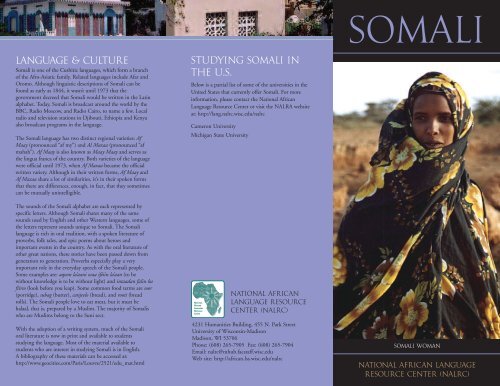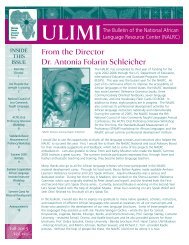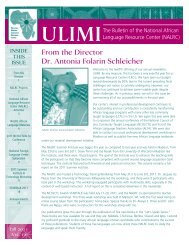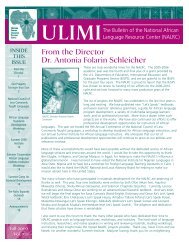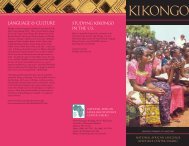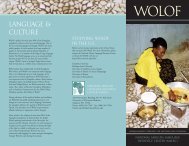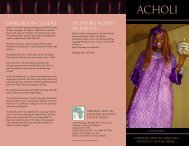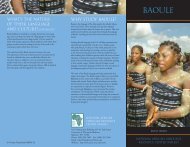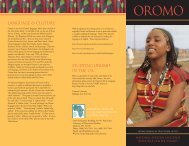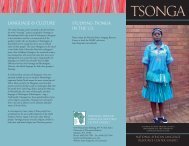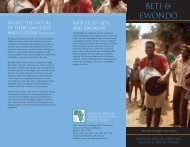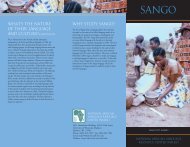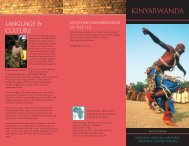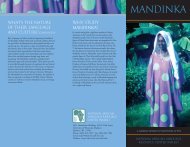Somali - National African Language Resource Center
Somali - National African Language Resource Center
Somali - National African Language Resource Center
Create successful ePaper yourself
Turn your PDF publications into a flip-book with our unique Google optimized e-Paper software.
<strong>Somali</strong><br />
<strong>Language</strong> & Culture<br />
<strong>Somali</strong> is one of the Cushitic languages, which form a branch<br />
of the Afro-Asiatic family. Related languages include Afar and<br />
Oromo. Although linguistic descriptions of <strong>Somali</strong> can be<br />
found as early as 1844, it wasn’t until 1973 that the<br />
government decreed that <strong>Somali</strong> would be written in the Latin<br />
alphabet. Today, <strong>Somali</strong> is broadcast around the world by the<br />
BBC, Radio Moscow, and Radio Cairo, to name a few. Local<br />
radio and television stations in Djibouti, Ethiopia and Kenya<br />
also broadcast programs in the language.<br />
The <strong>Somali</strong> language has two distinct regional varieties: Af<br />
Maay (pronounced “af my”) and Al Maxaa (pronounced “af<br />
mahah”). Af Maay is also known as Maay Maay and serves as<br />
the lingua franca of the country. Both varieties of the language<br />
were official until 1973, when Af Maxaa became the official<br />
written variety. Although in their written forms, Af Maay and<br />
Af Maxaa share a lot of similarities, it’s in their spoken forms<br />
that there are differences, enough, in fact, that they sometimes<br />
can be mutually unintelligible.<br />
The sounds of the <strong>Somali</strong> alphabet are each represented by<br />
specific letters. Although <strong>Somali</strong> shares many of the same<br />
sounds used by English and other Western languages, some of<br />
the letters represent sounds unique to <strong>Somali</strong>. The <strong>Somali</strong><br />
language is rich in oral tradition, with a spoken literature of<br />
proverbs, folk tales, and epic poems about heroes and<br />
important events in the country. As with the oral literature of<br />
other great nations, these stories have been passed down from<br />
generation to generation. Proverbs especially play a very<br />
important role in the everyday speech of the <strong>Somali</strong> people.<br />
Some examples are: aqoon la’aani waa iftiin la’aan (to be<br />
without knowledge is to be without light) and intaadan falin ka<br />
fiirso (look before you leap). Some common food terms are soor<br />
(porridge), subag (butter), canjeelo (bread), and rooti (bread<br />
rolls). The <strong>Somali</strong> people love to eat meat, but it must be<br />
halaal, that is, prepared by a Muslim. The majority of <strong>Somali</strong>s<br />
who are Muslims belong to the Suni sect.<br />
With the adoption of a writing system, much of the <strong>Somali</strong><br />
oral literature is now in print and available to students<br />
studying the language. Most of the material available to<br />
students who are interest in studying <strong>Somali</strong> is in English.<br />
A bibliography of these materials can be accessed at:<br />
http://www.geocities.com/Paris/Louvre/2521/edu_mat.html<br />
Studying <strong>Somali</strong> in<br />
the U.S.<br />
Below is a partial list of some of the universities in the<br />
United States that currently offer <strong>Somali</strong>. For more<br />
information, please contact the <strong>National</strong> <strong>African</strong><br />
<strong>Language</strong> <strong>Resource</strong> <strong>Center</strong> or visit the NALRA website<br />
at: http://lang.nalrc.wisc.edu/nalrc<br />
Cameron University<br />
Michigan State University<br />
<strong>National</strong> <strong>African</strong><br />
<strong>Language</strong> <strong>Resource</strong><br />
<strong>Center</strong> (NALRC)<br />
4231 Humanities Building, 455 N. Park Street<br />
University of Wisconsin-Madison<br />
Madison, WI 53706<br />
Phone: (608) 265-7905 Fax: (608) 265-7904<br />
Email: nalrc@mhub.facstaff.wisc.edu<br />
Web site: http://african.lss.wisc.edu/nalrc<br />
<strong>Somali</strong> Woman<br />
<strong>National</strong> <strong>African</strong> <strong>Language</strong><br />
<strong>Resource</strong> <strong>Center</strong> (NALRC)
Why Study<br />
<strong>Somali</strong><br />
The <strong>Somali</strong> language is spoken by over 20 million<br />
people world-wide. In Africa, it is the national<br />
language of <strong>Somali</strong>a and is the second language of<br />
large segments of the population in Djibouti, Eritrea,<br />
Ethiopia, and Kenya. With the recent immigration<br />
of <strong>Somali</strong>s to other continents, the language is now<br />
spoken widely in the Middle-East, Western Europe,<br />
and North America.<br />
As more and more <strong>Somali</strong> speakers settle in the<br />
United States, there has been a surge of interest in<br />
studying the language, not only so people can<br />
communicate more easily with their new neighbors,<br />
but also so they can learn about the rich <strong>Somali</strong><br />
culture.<br />
Knowledge of the<br />
<strong>Somali</strong> language is<br />
crucial to anyone<br />
in linguistics,<br />
anthropology,<br />
history, and<br />
folklore who<br />
wants to study in<br />
East Africa.<br />
Individuals<br />
working for<br />
international<br />
<strong>Somali</strong> boy with camel. organizations,<br />
such as the Peace<br />
Corps, will also find that they can accomplish their<br />
day-to-day tasks more easily if they can speak<br />
<strong>Somali</strong>. Tourists, too, will soon discover that<br />
knowledge of the <strong>Somali</strong> language will allow them to<br />
communicate with the local residents and enjoy their<br />
holiday more.<br />
Who Speaks<br />
somali<br />
People<br />
and<br />
History<br />
Archaeological evidence<br />
indicates that the people<br />
who live in present day<br />
<strong>Somali</strong>a had occupied the<br />
Horn of Africa by 100<br />
Woman with ‘heena’<br />
on hands.<br />
A.D.—possibly even<br />
earlier. These early nomads<br />
showed signs of a highly<br />
developed pastoral culture. They were also followers of<br />
Islam. Their first contact with this religion probably<br />
occurred when a group of persecuted Muslims sought<br />
refugee in the region at the time of the prophet<br />
Muhammad in the eighth century. Eventually, the<br />
original inhabitants divided into two distinct groups:<br />
the pastoral people who lived in the interior, with<br />
informal and varying political structures; and the<br />
trading communities of the coast, with administrative<br />
and legal systems based on the Muslim sharia.<br />
Today, the <strong>Somali</strong>s (Samaal) are divided into six major<br />
clan-families. Four of these are still predominantly<br />
nomadic—the Dir, Darood, Isaaq, and Hawiye.<br />
Together, these four groups represent 70 percent of<br />
<strong>Somali</strong>a’s population. The two remaining clan-families<br />
are agricultural, the Digil and the Rahanwayn. They<br />
constitute about 20 percent of the country’s<br />
population. The rest of <strong>Somali</strong>a’s inhabitants are<br />
comprised of urban dwellers and marginal non-Samaal<br />
groups. Most of these groups engage in trade or crafts<br />
and have historically not played a political role in the<br />
country or been a part of the Samaal warrior tradition.<br />
Over the centuries, <strong>Somali</strong>a and the rest of the East<br />
<strong>African</strong> coast have been subject to various rulers,<br />
including the Omanis, the Zanzibaris, the Sharifs of<br />
Mukha in present-day Yemen, and the Ottoman Turks.<br />
Exhibiting handicrafts at a <strong>Somali</strong>land trade fair.<br />
Mosque in Mogadishu.<br />
<strong>Somali</strong> nomads.


